What Are Topic Clusters?
Bob Dylan once said, “The times, they are a changin’,” and while he probably wasn’t talking about topic clusters, we marketers can live by the sentiment.
Let’s face facts here: customers are using different ways to search. We’re tasked to adapt to that change.
To know why exactly Bobby would be singing about topic clusters, we need to have an idea of what they are. So what’s a topic cluster?
Topic clusters are webpages that all link between each other. These pages are usually organized around one central theme on a page. Those central themes are called pillar pages.
Think of topic clusters as chapters on a DVD or Blu-Ray. Film content in those formats is segmented according to content, which is what topic clusters are about.
Topic clusters are integral parts of today’s content strategy. By getting all of your ducks in a row, content-wise, you stand a better chance for search engines to recognize the effort you took to do so.
You build topic clusters to organize your content in order to increase the chances of your content having a positive impact on website visitors.
Topic clusters, though, are more than mere groups of content tied together by a uniting theme. They also go further than that. Think about how books are structured. You have the book—that’s the central theme, the pillar page.
Then that book is divided by similar content—those are the chapters.
The part where it gets deeper is that those chapters are composed of words. The words represent subtopics.
Another way to think about it is to imagine that you’re casting a net on a commercial fishing trip. The net is the topic cluster—it covers a wide swath.
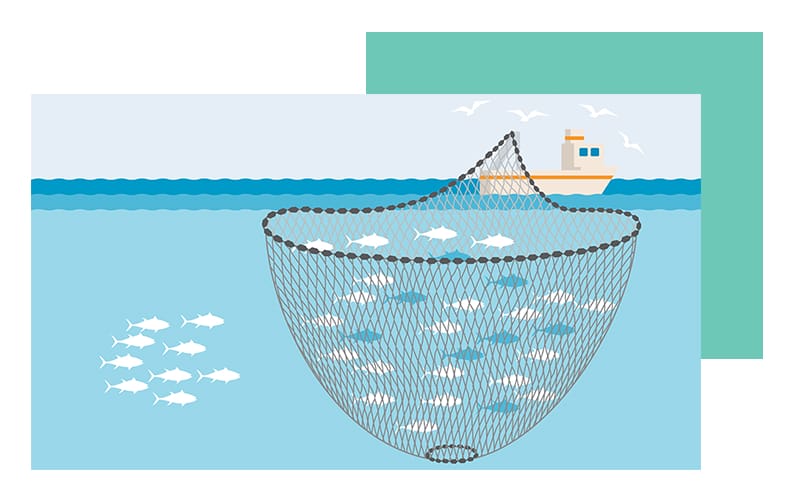
Source: Sustainable Fisheries.
When it’s time to haul the net up, you have a lot of fish—pillar page ideas.
You sort the fish out—keep the good, release the undesirable.
And there you have your actual pillar pages—the fish that you’re keeping. Those are the fish you’ve sorted out, and grouped by similarity.
But within the pillar pages—the fish you’re keeping—are subtopics. These are the fish that get bought when you take them to market. After all, nobody wants ALL of your fish.
Only a certain amount of what you caught—subtopics.
Why Are Topic Clusters Important?
As I’ve sort of hinted at earlier, topic clusters get your content recognized by search engines and deliver what your audience considers valuable. You want your content to be considered worthwhile because content is a competitive arena. Only the strong survive.
And with search engines switching up their algorithms all the time, any new changes may feel like they’ve been written in the Wingdings font. You had just gotten used to the latest search engine overhaul.
But if you organize relevant content for your audience through content clusters, you’re more likely to get ranked by search engines and read by your audience. It’s a mutually-reinforcing relationship. It’s good for the audience—they get useful content. It’s good for you because you want to be found.
Topic clusters also happen to be the best way to organize and prepare relevant content for your audience. Ultimately, topic clusters embody the golden rule of marketing: make sure people want what you’re offering.
Admittedly, the golden rule of marketing these days is made even harder by the constant flow of content. With so much stuff coming out, and all at once, it’s easy for prospects to get overwhelmed by the choices.
Sure, prospects may find the answer on one set of your marketing materials. For them, problem solved—their search is may well be over. But the whole beauty of topic clusters, when done the right way, is that they all interlink among each other in a way that complements.
For example, unless you’ve been living under a rock, you’ll have noticed that when you search on Google, Google will offer you results of your search terms, but also what other people search for.

Not only that, but Google also offers related terms in relation to what’s searched for.
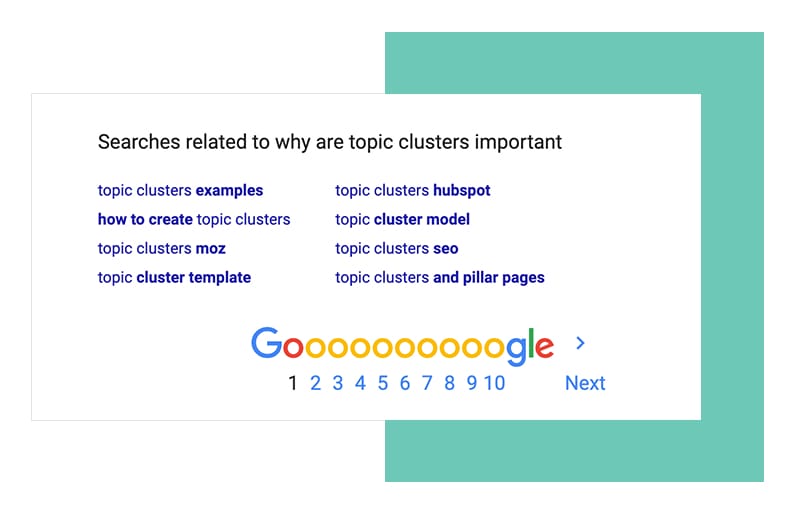
This is a perfect example of why topic clusters are important. They help prospects and customers get what they need without extensively searching for the answers to their problems, or worse, searching your competitors for answers to your problem.
In short, topic clusters help a prospect realize they need your service before they know they need it.
How Marketers Arrived Here
The idea of creating topic clusters hasn’t been around forever. In fact, it’s a fairly new strategy, only emerging onto the scene within the past couple of years on the HubSpot blog.
You may be wondering which methods marketers used before topic clusters. But before I bore you to death about where topic clusters fit into the SEO tactics of 5, 10, even 20 years ago, I should tell you why the history of SEO matters here.
To understand what happens in the present, and how that might shape the future, you have to know what’s happened in the past. And while that’s true of virtually anything under the sun, it’s particularly important to SEO. It always helps to know how search ended up at this point.
When SEO first started, the focus was on keywords. Back then, if you could mention the focus keyword as many times as you could, you’d be rewarded with an elevated search ranking.
This practice of cramming your focus keyword into your content as much as you could was called keyword stuffing. An example of this from WordStream is provided below.

Google came to save the day by introducing links and the PageRank algorithm sometime later. Marketers and SEO practitioners far and wide collected high-quality links to rank higher in Google’s search algorithm. Some even asked for high-domain websites to link to them, others paid for links.
Google penalized them accordingly, making updates here and there to address new issues that arose.
And for a while, links made sense. Think about it this way: if you had a problem and a family member with whom you’re close referred you to a solution that might help, why not trust them? In the same sense, if a well-established and trusted source of online B2B information recommended a certain site, how likely would you be to try what they’ve recommended?
But now just having other websites vouch for you isn’t enough. In the age of instant gratification and marketers pumping out content every day, prospects feel confused who they should turn to.
This is where topic clusters come out to play.
You understand what topic clusters are, what they’re used for, but how are they used practically? Seeing topic clusters in action is always the best way to learn about them.
In other words, we learn by doing—it’s why some ideas stick and some don’t. Dan and Chip Health wrote a wonderful book titled, Made to Stick. It’s about why some ideas stick and some don’t.
But if we all learn by doing, check out some rad examples of how a few business organizations did the pillars of their topic clusters.
The Atlantic
The Atlantic devised a pillar page for their content cluster that is heavy on the visuals, but it’s not a static picture—these visuals move as you scroll. It certainly is dynamic, informing while engaging the visitor.
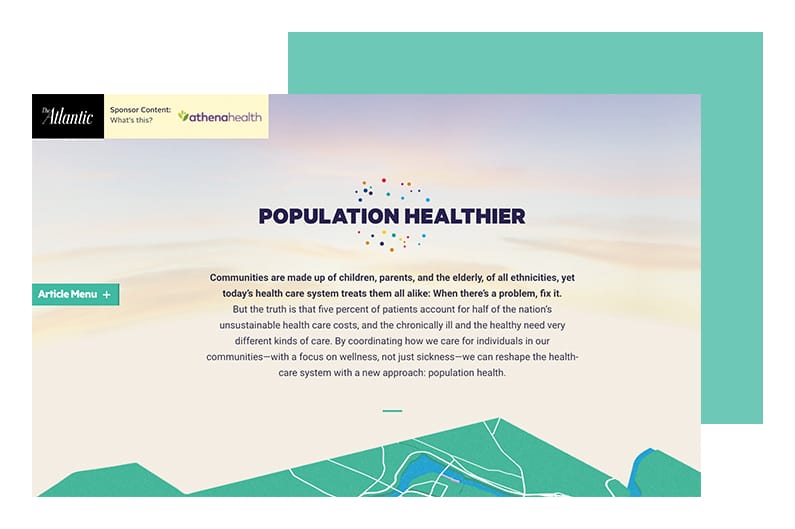
But it’s not just a visual page! No, as I’ve mentioned, it is a pillar page. People who view this site will notice that The Atlantic gives them access to other articles at the bottom.
Given that knowing where to go on a website for information has historically been a hassle for people in and out of business, The Atlantic solves this problem by including all content on the same page.
Smart. People lose interest if there’s a lot to scroll through, but if it’s made engaging, why would they stop?
Matthew Barby’s Customer Acquisition Strategies
Matthew Barby, among other titles he juggles, is the Director of Acquisition at HubSpot. Since the whole topic cluster strategy started with HubSpot, I guess you might expect him to know “something” about it.
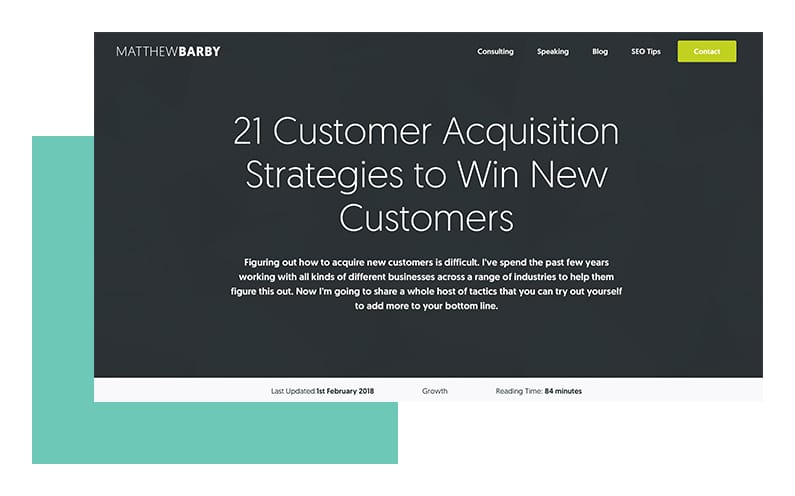
And indeed he does! When you sit down to write something that takes on average 85 minutes to read it’s a safe bet that what you’re saying is worthwhile. That’s next-level time commitment!
And given the range of his expertise at customer acquisition strategies, SEO has been very kind to him. By essentially branding his content with a timestamp, readers don’t have to determine how old information is. It’s stated when it was last updated.
How Marketers Can Mess Up Content/Topic Clusters
Both of these content cluster examples are times where marketers actually get them right.
Unfortunately, though, many marketers make mistakes when adopting topic clusters. I’m not saying that topic clusters are a bad way to go—the strategy is sound—but HubSpot has the unfortunate habit of making anything sound easy.
Not everybody can do what marketers can do. This is true of virtually anything. Not everybody is a natural at sports. Math doesn’t come easy to all.
But enough about that. There are four main areas marketers choke when creating topic clusters. More specifically, marketers botch the pillar pages that form the topic clusters. Pillar pages, as you’ll recall, are the major themes that the clusters are based on, or the fish you’ve kept, sorted, and are taking to market.
The main areas that lead marketers to create topic clusters have to deal with pillar page focus on and what they include:
- Poor pillar pages are those that are so specialized—so niche—that marketers have trouble attracting the right audience.
- Bad pillars can also be about something too big for the page to attract the right people.
When you create a pillar page, normally you’d want to pick a broad, but unique, keyword. But the thing is at times even when you pick a keyword that seems broad, there aren’t enough long-tail variations.
The same thing goes for pillars that are too broad. There’s a difference between something that’s directly related to your pillar, related, and related to a topic that’s related to your pillar.
You don’t want that last one. Content clusters are supposed to be inclusive, but they have to resemble pillar content.
- Marketers make pillars so similar they borrow too many terms from each other. And with Google changing all of the time, it’s always evolving to get at knowing a searcher’s intent. What this means is that Google will think the similar pillar pages are the same. One will overpower the other, ignoring the overpowered.
- Marketers wind up competing against each other. Google will not understand that slightly different pillars are actually different. In sum, when creating pillars, don’t be too broad, but don’t also pick keywords that will wind up at long-tail dead ends.
When to Use Topic Clusters
You use topic clusters when you want to beef up your content strategy while improving your SEO score and improving your reputation among your customers.
To put a finer point on it, when you use topic clusters for SEO, you actually make it easier for search engines’ web spiders to map out and index the contents of your page. This due in part to the relevance of your pillar pages in relation to your topic cluster.
But Google doesn’t reward you for that. They’ll recognize the relationships between the pillar pages and the topic clusters. Accordingly, they give a better ranking in search because it’s organized so well.
And because you’ll rank better in search, prospects will be able to find your valuable content easier. This will help to cultivate trust in your business relationship with prospects. It’ll also help keep your content strategy streamlined. You can churn out pillar page ideas much easier.
For example, you can even use Google to help you out with pillar page ideas. Just look at the related search terms at the bottom of search results. Using this method gives you ideas about ways to repurpose content, as well. It makes the process of brainstorming ideas less tiresome.
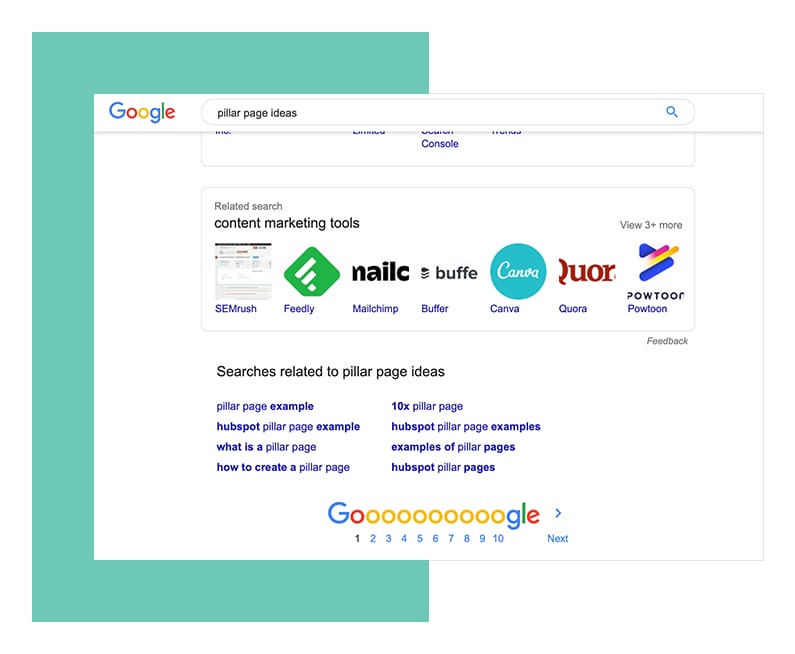
But pillar pages require constant maintenance to ensure accuracy in order to maintain search rankings and reputation among customers. This routine checking can be a drain on your marketing resources.
With us marketers being budget-constrained enough as it is, if we decide to add topic clusters to our content strategies, we need to execute them correctly.
To do that, you need to know how to create a topic cluster.
How to Create Topic Clusters
To begin, it’s always a good idea to start with a broad idea that branches off into niche categories.
For example, think of it as something in the scope of a pair of binoculars. What you see in a pair of binoculars. What you see—that’s your topic. The environment your topic is in? Those are the subtopics. Create pillars according to this example and you’ll be fine.
Next, you want to do a content audit of the stuff you already have. Those can make great pillar pages. And I know what you’re thinking. The idea of a content audit is enough to make most marketers shudder.
But really, you’re just going through your content for pillar page ideas and similar content to that of the pillar you want to create. If you find gold, you should keep it, adjust accordingly, and let that puppy loose.
So you’ve got your content audit out of the way. Pillar page ideas have been identified. Similar topics and ideas have been grouped together. Every piece of content you have has been reviewed for similarity in comparison to other pieces and pillar page ideas.
Now what? Well, you’re not going to get very far anywhere if these topics aren’t linked. And when I say linked, I don’t mean merely linking to the pillar page. That just tells a search engine that Topic A is related to Topic B.
Here, the topic cluster is the pin, the threads are pillar pages, and the way they’re tied around the pin—touching each other—represents interlinking.
The very last step of building a content cluster that works, you need to make sure it’s hitting established benchmarks for performance.
Does the cluster meet your expectations? What goals might you set to continue that trend? If the results are underwhelming, what can you do to address what’s underperforming so that it does reach your goals? It’s a lot of wait and see here.
As one of the top digital marketing agencies in Boston, we here at MESH have you covered. Chat directly with agency Founder Bill Schick on the chat box in the lower right-hand corner to get a conversation started about getting you where you want to be. Feel free to say hello, or give us a call at 844-432-8987.
Digital Marketing Agency
MESH is a digital marketing agency that has pioneered Account-Based Marketing via our proprietary Outcome Driven Marketing (ODM) methodology. We keep our focus on tightly integrating (or MESHing) lead generation, inbound, and outbound methodologies. We help you understand the hidden levers that impact your customers’ buying decision process, develop the right marketing strategy for your unique business case, and effectively execute and measure all aspects of your Account-Based Marketing program.




